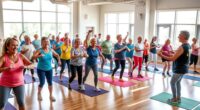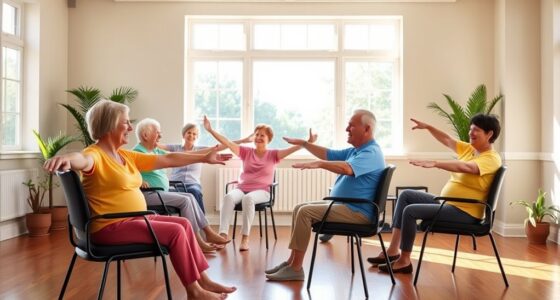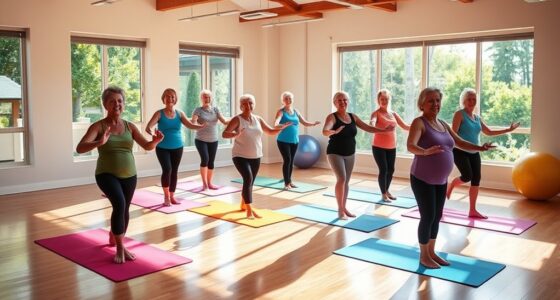Seated leg exercises are a fantastic way for you to strengthen your legs and enhance mobility without standing. They boost balance, reduce fall risks, and improve circulation. Try knee extensions, calf raises, and seated marches to target key muscle groups effectively. Remember to maintain good posture, and start each session with a warm-up. It’s important to stay consistent for the best results. Want to discover more exercises and tips for your routine? Keep exploring!
Key Takeaways
- Seated leg exercises enhance mobility, balance, and independence without the need to stand, making them ideal for seniors.
- Key exercises include knee extensions, calf raises, chair squats, leg lifts, and seated marches to strengthen leg muscles effectively.
- Safety is crucial; use a sturdy chair, maintain good posture, and consult a healthcare provider before starting any exercise routine.
- Aim for 2-3 sessions per week, lasting 15-30 minutes, with warm-ups and cool-downs to maximize benefits and prevent injuries.
- Professional guidance can provide tailored exercise plans, ensuring safe practices and proper technique for optimal results.
Benefits of Seated Leg Exercises for Seniors

When you engage in seated leg exercises, you not only boost your strength and mobility, but you also enhance your overall quality of life. These exercises are essential for improving strength in your lower body, making daily activities like walking and climbing stairs easier. Additionally, individual responses to exercise can vary based on personal health conditions, so it’s important to listen to your body and adjust as needed. By focusing on balance and coordination, seated leg exercises reduce falls, allowing you to feel more secure in your movements. Furthermore, they promote flexibility and joint health, which is especially beneficial if you have arthritis. Regular practice supports functional fitness and independence, empowering you to maintain an active lifestyle. Best of all, these exercises are accessible and can be done with minimal equipment, making them perfect for home or care facility settings. Prioritizing balanced nutrition can further motivate you to incorporate seated exercises into your routine. Engaging in these exercises also aids in improving overall health, which is vital for seniors looking to enhance their well-being. Moreover, developing a consistent exercise routine can support advanced care planning, ensuring that you remain active and self-sufficient as you age.
Key Seated Leg Exercises to Try
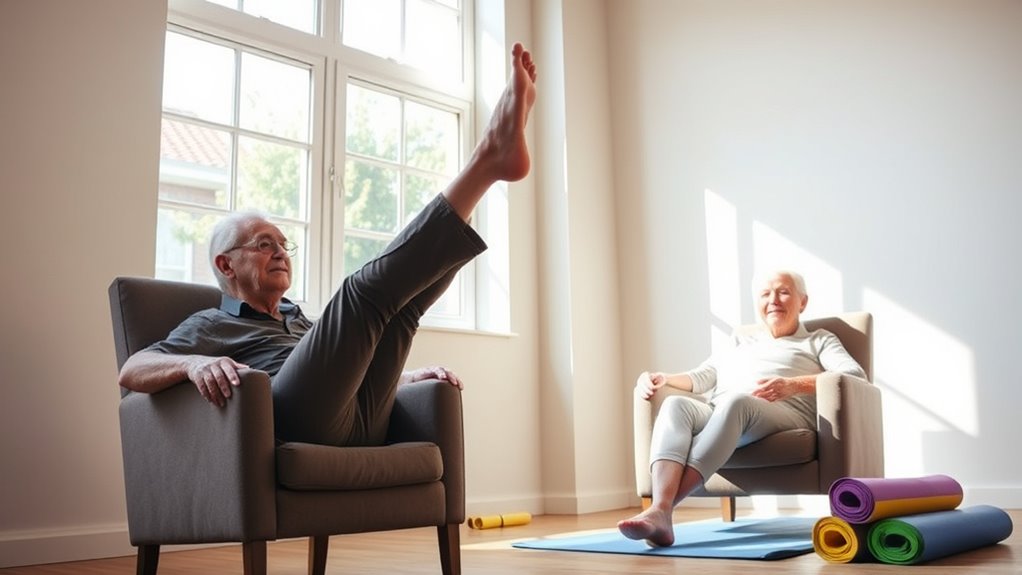
Here are five key seated leg exercises you can easily incorporate into your routine to strengthen your lower body and enhance mobility:
- Knee Extensions: Target your quadriceps for improved strength and stability. Engaging in regular exercise can help promote emotional health and resilience.
- Calf Raises: Strengthen your calves to support better balance and coordination.
- Chair Squats: Engage both quadriceps and hamstrings while promoting functional fitness.
- Leg Lifts: Work your lower body muscles effectively, enhancing overall mobility.
Incorporating regular exercise can also improve overall health and reduce risks associated with infant feeding options.
Safety Tips for Practicing Seated Exercises
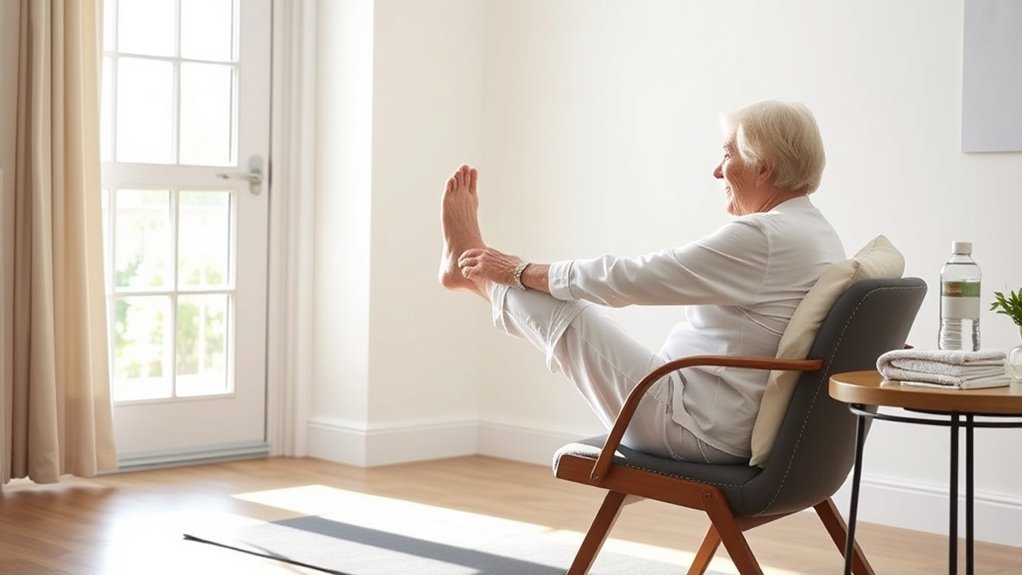
Practicing seated exercises can be a great way to improve strength and mobility, but safety should always come first. Start by consulting your healthcare provider, especially if you have health conditions or recent surgeries. Additionally, be mindful of your risk factors for any underlying health issues that could affect your exercise routine. Courts often consider financial misconduct when determining alimony, which can impact your overall financial health as you age. It’s also important to incorporate retirement savings options into your financial planning to ensure you have the resources needed for potential care as you age. Engaging in regular exercise can also help mitigate brain fog effects in seniors, enhancing overall cognitive function.
Practicing seated exercises can enhance strength and mobility, but always prioritize safety and consult your healthcare provider first.
Use a sturdy chair without arms for stability, and maintain proper posture by sitting upright with your feet flat on the floor. Begin with gentle movements and gradually increase intensity to avoid strain.
Always listen to your body—if you feel pain or discomfort, stop the exercise immediately. Staying hydrated is essential, and incorporating relaxation techniques before and after your session can enhance effectiveness. Additionally, consider the importance of long-term financial planning for any potential care needs as you age.
Following these safety tips will help you enjoy seated exercises safely and effectively.
How to Incorporate Seated Leg Exercises Into Your Routine
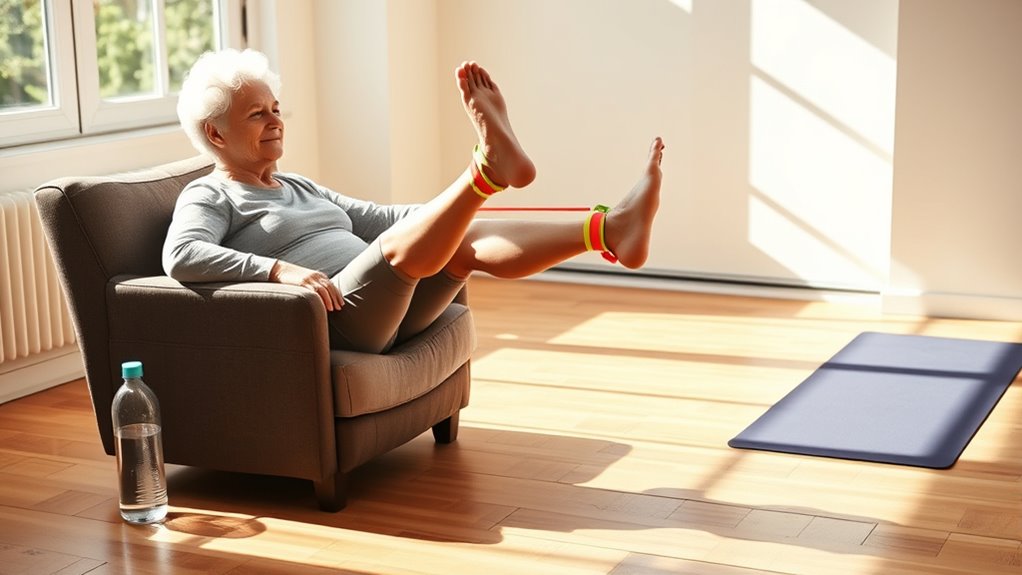
Incorporating seated leg exercises into your routine can be simple and effective, especially if you focus on consistency. Start each session with a warm-up, like seated marching or arm circles, for 30-60 seconds. Additionally, sustainable living practices can enhance your overall health and well-being. Following a nutritious diet, including high protein and fat consumption, can support your exercise efforts and overall muscle function.
Then, include exercises like seated knee extensions and pillow squeezes to strengthen your muscles. Use a chair for support to guarantee safety and comfort, ensuring that your environment is elderly-friendly for maximum ease. Additionally, fresh orange juice can be a great way to stay hydrated and support muscle function.
- Feel empowered as you improve mobility.
- Gain strength and endurance for daily activities.
- Enjoy the benefits of low-impact exercise, perfect for limited mobility.
- Embrace the journey of muscle strengthening and physical therapy.
Aim for a few sessions each week to make progress and enhance your overall well-being. You’ll appreciate the difference these exercises make! Additionally, remember that emotional and psychological growth can be positively influenced by regular physical activity, contributing to overall well-being.
Expert Recommendations for Seniors Engaging in Seated Exercises
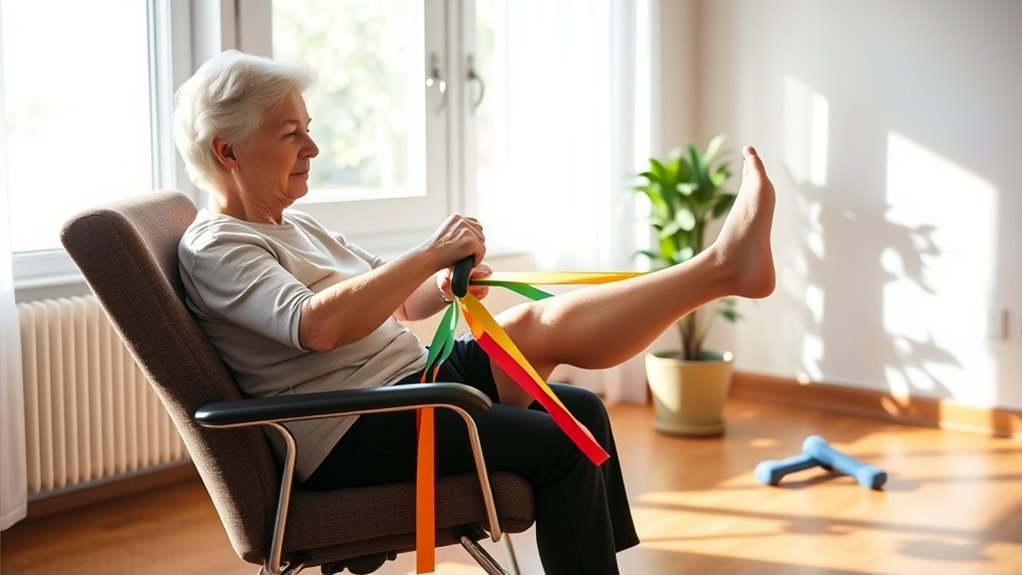
As you explore seated exercises, it’s essential to follow expert recommendations that prioritize safety and effectiveness. Engaging in these activities helps strengthen leg muscles and improve mobility, important for older adults. Aim for at least two days of muscle-strengthening exercises each week, as suggested by physical therapists. This routine enhances balance and prevents falls, critical for maintaining independence in activities like walking. Additionally, seated exercises promote circulation and flexibility, alleviating discomfort often associated with heart disease and stiffness. Incorporating problem-solving abilities into your exercise routine can help you adapt movements to your personal comfort and capability levels. Understanding the importance of emotional regulation can also enhance your overall experience during exercise. Regular participation in play activities, even in a seated position, can help maintain cognitive function and emotional well-being. Ensuring regular routine checkups with a healthcare provider can further support your overall wellness and safety during exercise. Furthermore, recognizing the potential risks associated with payment technologies can help you stay informed about safety measures while engaging in these exercises.
| Recommendation | Benefits |
|---|---|
| Perform leg raises | Strengthens leg muscles |
| Include knee extensions | Improves mobility |
| Maintain a consistent routine | Enhances fitness levels |
| Consult a physical therapist | Guarantees safe practices |
Frequently Asked Questions
How Can I Strengthen My Legs While Sitting Down?
You can strengthen your legs while sitting down by performing simple exercises like knee extensions and calf raises.
Try lifting your toes while keeping your heels on the ground to engage your calves. For your quadriceps, extend one leg at a time and hold for a few seconds.
Don’t forget ankle pumps to boost circulation. These exercises can enhance your strength and flexibility, making daily activities easier and helping you stay active.
Do Seated Exercisers Work for Seniors?
Yes, seated exercises definitely work for seniors! You can effectively strengthen your legs while sitting down, making it a safe option that minimizes the risk of falls.
These exercises target key muscle groups, enhancing your mobility and overall fitness. Plus, they’re easy to integrate into your daily routine, requiring little space or equipment.
How to Strengthen Weak Legs in the Elderly?
To strengthen weak legs in the elderly, focus on consistency, variety, and safety.
You can incorporate seated exercises like knee extensions, calf raises, and ankle pumps into your routine. Gradually increase resistance with light weights or resistance bands for added challenge.
Remember to maintain proper posture and breathe steadily.
How to Strengthen Legs While Lying in Bed?
To strengthen your legs while lying in bed, try incorporating some effective exercises.
Start with lying leg raises, lifting one leg straight up, then switch to ankle pumps to improve circulation.
You can also do knee extensions by bending and straightening your knees.
Side leg lifts will target your hip abductors, while gentle heel slides can enhance flexibility.
These exercises help build strength without any added strain on your legs.
Conclusion
Incorporating seated leg exercises into your routine can feel like planting seeds in a garden; with time and care, you’ll cultivate strength and stability. By embracing these movements, you’re not just staying active—you’re nurturing your body’s resilience. Remember, even from a seated position, you can rise to new heights of health. So, take a moment each day to tend to your physical well-being, and watch as you flourish, rooted in strength and vigor.

